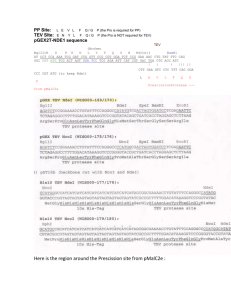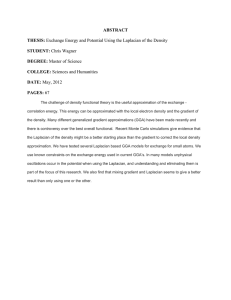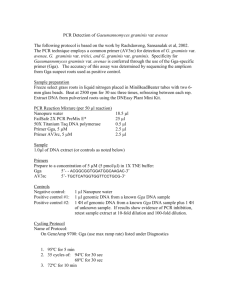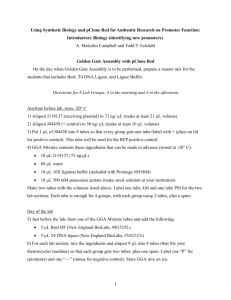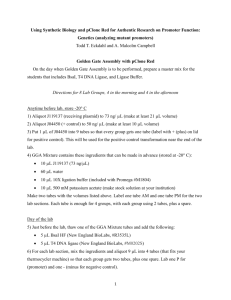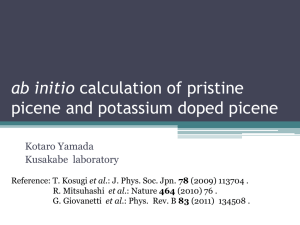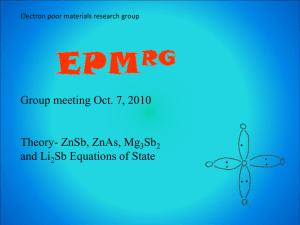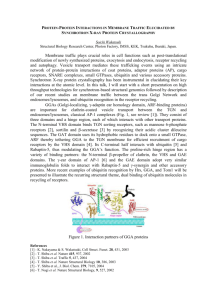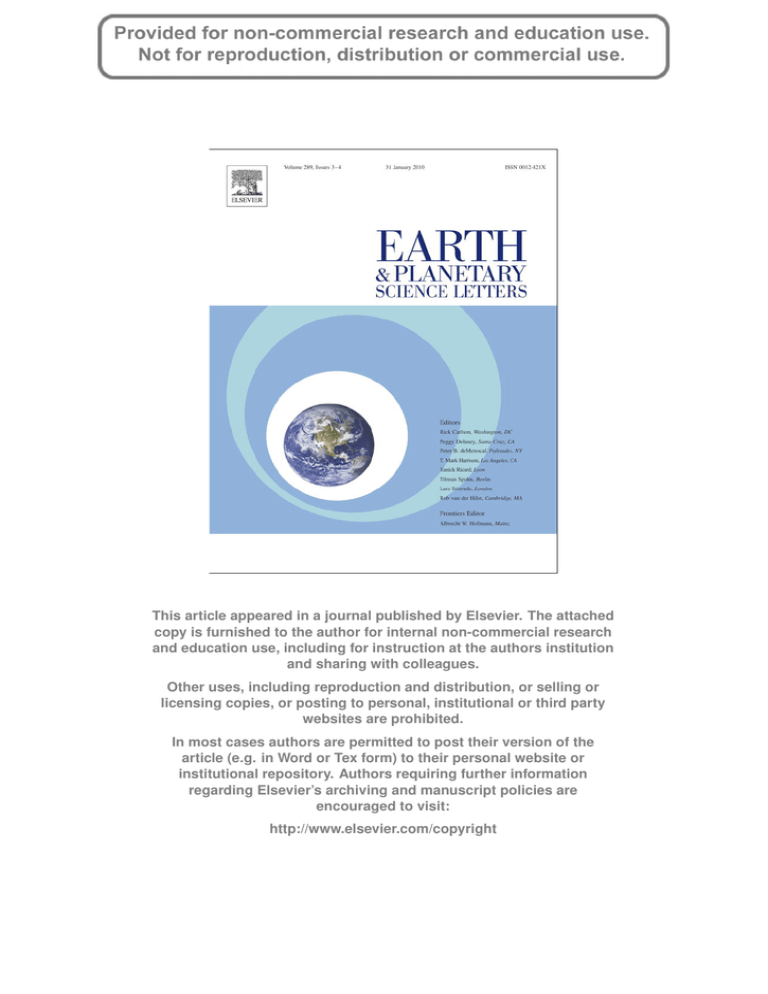
This article appeared in a journal published by Elsevier. The attached
copy is furnished to the author for internal non-commercial research
and education use, including for instruction at the authors institution
and sharing with colleagues.
Other uses, including reproduction and distribution, or selling or
licensing copies, or posting to personal, institutional or third party
websites are prohibited.
In most cases authors are permitted to post their version of the
article (e.g. in Word or Tex form) to their personal website or
institutional repository. Authors requiring further information
regarding Elsevier’s archiving and manuscript policies are
encouraged to visit:
http://www.elsevier.com/copyright
Author's personal copy
Earth and Planetary Science Letters 289 (2010) 449–456
Contents lists available at ScienceDirect
Earth and Planetary Science Letters
j o u r n a l h o m e p a g e : w w w. e l s ev i e r. c o m / l o c a t e / e p s l
Determination of the high-pressure properties of fayalite from
first-principles calculations
Stephen Stackhouse a,⁎, Lars Stixrude b, Bijaya B. Karki c
a
b
c
Department of Geological Sciences, University of Michigan, 1100 North University Ave., Ann Arbor, Michigan, 48109-1005, USA
Department of Earth Sciences, University College London, Gower Street, London WC1E 6BT, UK
Department of Computer Science, Louisiana State University, 283 Coates Hall, Baton Rouge, LA 70803, USA
a r t i c l e
i n f o
Article history:
Received 6 June 2009
Received in revised form 17 November 2009
Accepted 18 November 2009
Editor: R.D. van der Hilst
Keywords:
first-principles
ab initio
GGA+U
fayalite
high-pressure
elastic properties
a b s t r a c t
We have calculated the high-pressure properties of fayalite, including band structure, magnetism, equationof-state and elastic properties using density functional theory within the generalized gradient approximation
(GGA) and using the GGA + U method. We show for the first time that the addition of an on-site Hubbard
repulsion term to the GGA leads to improved agreement between calculated and experimental values of
structural and elastic properties, as well as electronic band gap, particularly at high pressure. High-pressure
elastic instability, originating in the vanishing of the elastic constant c44 and previously predicted on the
basis of extrapolated experimental data, is found with the GGA + U method. Experimental measurements
of the elastic constants agree better with the GGA + U method, than with the GGA, which calls for a
reassessment of the structural and elastic properties of iron-bearing minerals calculated using standard
density functional theory, which have hitherto been used to interpret the structure and dynamics of the
mantle. The improvement can be related to the better description of magnetic structure: without the
Hubbard U the magnetic moments on the iron ions decrease with pressure, whereas when it is included they
remain almost constant, at least, up to the highest pressure studied. This also leads to better predictions of
equation-of-state. Our calculated partial density-of-states indicate that the lowest energy excitation across
the electronic band gap lies within the d-orbital manifold, and we argue that this is not observed at ambient
pressure because the signal in the optical spectrum is too weak, accounting for apparent discrepancies with
reported experimental values. Upon compression the nature of the gap changes due to the broadening of the
3d manifold, and this likely renders the fundamental gap observable in optical spectroscopy at high pressure,
accounting for the better agreement between theory and experiment above 20 GPa. We associate the
changes in the character of the bands with a change in the crystal structure.
© 2009 Elsevier B.V. All rights reserved.
1. Introduction
Fayalite is the pure iron end-member of olivine, thought to be the
most abundant phase in the Earth's upper mantle (Ringwood, 1970).
Olivine is expected to predominate from the base of the crust to the
410 km seismic discontinuity and may be preserved (in a metastable
state) to greater depths in subducting slabs (Green and Burnley, 1989;
Wu et al., 1993). It is important to understand the influence of iron on
the properties of olivine, because of its unusual characteristics as
compared with the other major cations, including its large mass and
electronic structure dominated by d-states. These lead to it having a
pronounced effect on density, elastic wave velocities and electrical
⁎ Corresponding author. Present address: Department of Earth and Planetary Science,
University of California, Berkeley, 307 McCone Hall, Berkeley, CA 94720-4767, USA.
Tel.: +1 510 642 7030; fax: +1 510 643 9980.
E-mail addresses: sstackho@umich.edu (S. Stackhouse), l.stixrude@ucl.ac.uk
(L. Stixrude), karki@csc.lsu.edu (B.B. Karki).
0012-821X/$ – see front matter © 2009 Elsevier B.V. All rights reserved.
doi:10.1016/j.epsl.2009.11.033
conductivity and thus, in turn, on mantle dynamics and the
interpretation of geophysical observations.
The high pressure behavior of fayalite allows us to explore two
important issues. The first of these is the behavior of silicates as they
are compressed outside their thermodynamic stability field. While the
thermodynamic stability field of olivine is well known (Yagi et al.,
1987), its behavior under metastable over-compression, as would
occur in a kinetically hindered subducting slab is still not well understood. Pressure-induced amorphization of silicates is often observed
(Richet and Gillet, 1997) and in some cases may be related to a
dynamical instability of the lattice (Kingma et al., 1993). Based on
extrapolation of experimental data, it has been proposed that an
elastic instability occurs in fayalite at about 35 GPa (Speziale et al.,
2004), and this could be related to the observed amorphization
transition (Williams et al., 1990; Richard and Richet, 1990; Andrault
et al., 1995). The second relevant issue concerns the nature of the
insulator to metal transition in silicates. Iron-free silicates have large
band gaps that apparently do not close until pressures well beyond
those at the center of the Earth (Umemoto et al., 2006), but iron-
Author's personal copy
450
S. Stackhouse et al. / Earth and Planetary Science Letters 289 (2010) 449–456
bearing silicates have much smaller band gaps that may be influenced
by the spin state of the iron cation (Badro et al., 2004). Experimental
studies suggest that the band gap of fayalite narrows under static
compression at low temperature (Williams et al., 1990), a phenomenon that could be related to the simultaneous observation of
pressure-induced amorphization.
We also consider fayalite an ideal testing ground for ab initio theory.
Density functional theory (DFT) (Hohenberg and Kohn, 1964; Kohn and
Sham, 1965) has been applied with much success to the study of a wide
range of mantle minerals (Karki et al., 2001; Brodholt and Vočadlo, 2006),
but studies of iron-bearing phases have been limited. This is because
transition metal oxides such as fayalite present a particular challenge to
the method, due to the strong correlation of electrons in the d-states. This
correlation is responsible for magnetism and insulating behavior in these
systems and its effects are not fully accounted for in the most widely used
approximations: the local density approximation (LDA) and generalized
gradient approximation (GGA). In view of this, density functional theory
can fail to predict the correct band structure of iron-bearing minerals, such
as iron oxide (Isaak et al., 1993a; Alfredsson et al., 2004) and fayalite
(Cococcioni et al., 2003; Jiang and Guo, 2004). In spite of this, it has
continued to be used to predict the elastic properties of iron-bearing
phases, such as silicate perovskite and post-perovskite (e.g. Kiefer et al.,
2002; Li et al., 2005; Caracas and Cohen, 2005; Tsuchiya and Tsuchiya,
2006; Stackhouse et al., 2006), on the assumption that they are less
affected. However this is unknown, since no corresponding experimental
data exists with which to compare. In contrast, abundant experimental
data exists for fayalite (Sumino, 1979; Graham et al., 1988; Wang et al.,
1989; Isaak et al., 1993b; Speziale et al., 2004), providing the possibility to
assess the accuracy of the method.
In the present work we also investigate an advanced method, referred
to as GGA+U, whereby strong correlation is captured via an additional
local Hubbard repulsion of magnitude U (Anisimov et al., 1991, 1997). This
approach can lead to improved predictions of crystal structure, band gaps,
and magnetic properties (Gramsch et al., 2003; Jiang and Guo, 2004;
Alfredsson et al., 2004; Cococcioni and de Gironcoli, 2005). However little
is known about the influence of U on elastic properties. One study found a
small effect, although in a system for which there is, yet again, no
corresponding experimental data (Stackhouse and Brodholt, 2008).
effective U parameter Ueff = U − J and refer to Ueff as simply U, which
is the notation adopted here. Self-consistent calculations indicate that
for fayalite U should be about 4.6 eV and 4.9 eV for the two distinct
iron sites (Cococcioni et al., 2003; Cococcioni and de Gironcoli, 2005).
In view of this, we used U = 4.8 eV. We also explored a range of
alternative values of U, between 1.0 eV and 6.0 eV.
In all our calculations we assumed a ferromagnetic state of order and
allowed the magnitude of the moment to vary. Fayalite is known to be a
non-co-linear anti-ferromagnet at low temperature with a Néel temperature of 65 K at ambient pressure, rising to 100 K at 16 GPa (Hayashi et al.,
1987). But at room temperature and above, the regime of primary interest
in geophysics and the comparison with high-pressure experimental data,
the moments are disordered. Since non-co-linear calculations are more
challenging and as the magnetic state at high pressure is poorly known,
ferromagnetic order seems a good first order assumption. In addition,
previous studies have shown that nature of the magnetic order has only
very subtle effects on crystal structure (Cococcioni et al., 2003; Jiang and
Guo, 2004).
At each volume considered, the structure was optimized allowing all
cell parameters and atomic positions to vary. Because of our particular
interest in mechanical instability, we took the unusual step of leaving the
symmetry unconstrained (P 1), increasing the computational expense of
the calculations considerably. Previous studies have shown that electronic
spin transitions can be associated with symmetry breaking, with
important consequences for predicted spin transition pressures (Bengtson
et al., 2008). Despite this extra freedom, we find that the olivine structure
was preserved during relaxation at all volumes, except for the smallest
volume in the GGA calculations. To determine the athermal elastic
constants three different orthorhombic and one triclinic strains of
magnitude ±0.5% were applied to the optimized models, and the atomic
positions allowed to fully relax in the strained configurations (Karki et al.,
2001). Then a second-order polynomial was fit to the relationship
between applied strain and induced, calculated stress.
In order to compare with experiment, the resulting athermal values
were converted to room-temperature adiabatic values making use of
the thermodynamic identity:
dcij
dcij
dcij
dP
=
+
dT V
dT P
dT V dP T
ð1Þ
2. Theory
Our calculations were performed using the projector-augmentedwave implementation (Blöchl, 1994; Kresse and Joubert, 1999) of the
density functional theory based VASP code (Kresse and Furthmüller,
1996a,b), which incorporates a simplified GGA+U scheme (Dudarev
et al., 1998). The exchange-correlation functional adhered to the PBE form
of the generalized gradient approximation (GGA) (Perdew et al., 1996)
and the potentials were generated using the following electronic
configurations: 3p6 3d7 4 s1 for iron, 3 s2 3p2 for silicon and 2 s2 2p4 for
oxygen. For all calculations the kinetic-energy cut-off for the plane-wave
expansion was 800 eV, the Brillouin zone sampled using a 4·2·4 special
k-point grid (Monkhorst and Pack, 1976) and the convergence criteria for
structural optimization was 10− 6 eV. For both the GGA and GGA+U
calculations we applied Fermi (i.e., physical) smearing (Mermin, 1965)
with a broadening width of 0.2 eV, except for calculation of the electronic
density-of-states when the tetrahedron smearing method with Blöchl
corrections (Blöchl et al., 1994) was used. These settings ensured that
calculated total energies were converged to less than one meV per atom
and elastic constants to within about one percent. For further information
on density functional theory and its application to mineral physics, the
reader is directed to a review (Stixrude et al., 1998).
The GGA + U method requires specification of an onsite exchange
interaction parameter J and onsite Coulomb interaction parameter U.
However in the most widely used implementation employed in the
present work (Dudarev et al., 1998), the results depend only on the
difference between these values. It is therefore common to define an
with values for the temperature derivatives of the elastic constants at
constant pressure taken from Isaak et al. (1993b), that for the isochoric
change in pressure with temperature from Anderson and Isaak (1995)
and those for the pressure derivatives of the elastic constants at constant
temperature from Speziale et al. (2004). Bulk and shear moduli were
computed as the Voigt-Reuss-Hill average (Hill, 1963).
To correct our athermal calculations for the influence of phonon
excitation and the well known under-binding tendency of the GGA, we
report pressures as:
PðV; TÞ = PVASP ðV; 0KÞ + PEMP + PZPM ðVÞ + PTH ðV; TÞ
ð2Þ
where P is the total pressure, PVASP(V, 0K) the (athermal) pressure
calculated by the VASP code at volume V and 0 K; PEMP a volume- and
temperature-independent empirical pressure correction; PZPM(V) the
pressure associated with zero-point motion and PTH(V, T) the thermal
pressure at volume V and temperature T (de Koker et al., 2008). The
empirical pressure correction PEMP was calculated as:
PEMP = −PVASP ðVEXP Þ
ð3Þ
where VEXP is the experimental volume at zero pressure and static
conditions computed using the thermodynamic model of Xu et al. (2008).
Values for PZPM(V) and PTH(V, T) were also computed using the
thermodynamic model of Xu et al. (2008). The calculated value of PEMP
for the GGA was −2.87 GPa. For the GGA+U method it was −5.36 GPa
with U=2.0 eV and −6.72 GPa with U=4.8 eV. These lie within the
Author's personal copy
S. Stackhouse et al. / Earth and Planetary Science Letters 289 (2010) 449–456
451
range of pressure corrections calculated in previous investigations (e.g
PEMP =−12.08 GPa for MgSiO3 perovskite using the GGA (Oganov et al.,
2001) and PEMP =+1.6 GPa for forsterite using the LDA (de Koker et al.,
2008)) and consistent with a host of other studies of silicates that find that
the LDA generally slightly overbinds and the GGA underbinds by a larger
amount.
3. Results
The calculated equation-of-state and lattice parameters of fayalite
are in good agreement with experimental values at low pressures,
irrespective of whether they were calculated with the GGA or GGA +U
method and the value of U used (Figs. 1 and 2; Table 1). The ambient
pressure lattice parameters calculated using the GGA + U method vary
less than a percent as U varies from 1 eV to 6 eV. The maximum
difference between the lattice parameters calculated with the GGA
and those of Fujino et al. (1980) is 1.70%, while the GGA + U method
does a little better, with a maximum difference of 0.30% with
U = 2.0 eV and 0.49% with U = 4.8 eV. Though it is significant that
the GGA and GGA + U method both accurately predict the correct
shape of the unit cell (i.e., c/a and b/a ratios), especially as the
structure is highly elastically anisotropic, the good agreement in the
zero pressure volume is due to the application of the empirical
pressure correction (Eq. (3)). This correction is larger for the GGA + U
pressures than the GGA pressures, which means that the well-known
under-binding tendency of the GGA is somewhat exacerbated by the
addition of U.
The situation is quite different at high pressures where the lattice
parameters and equation-of-state calculated using the GGA and GGA+ U
method diverge. The GGA predicts lattice parameters and an equationof-state that differ from experimental values at high pressures. In
particular, the GGA predicts an equation-of-state that is much too soft. In
contrast, the two sets of GGA+ U values are in good agreement with
experimental values and each other at nearly all pressures. In particular,
the GGA +U values agree with experiment to within experimental
Fig. 2. Lattice parameters of fayalite as a function of pressure, calculated using the GGA and
GGA +U method, with U = 2.0 eV and 4.8 eV, and corresponding experimental data. Note
that, Kudoh and Takeda (1986) studied an (Fe0.920Mn0.055Mg0.020Si0.005)2SiO4 composition; Williams et al. studied an Fe2SiO4 composition; Andrault et al. (1995) studied an
(Fe0.99Mn0.01)2SiO4 composition; and Zhang (1998) studied an Fe2SiO4 composition.
uncertainty, except for the highest pressure volume measurements of
Andrault et al. (1995) and the highest pressure measurements of the b
axis of Williams et al. (1990). However it is likely that these highpressure experimental data are biased by non-hydrostaticity (Speziale
et al., 2004).
The calculated ambient pressure elastic constants of fayalite depend
a great deal on the value of U used (Fig. 3). The elastic constants increase
with increasing U at fixed volume, except for the off-diagonal elastic
constants (c12, c13, c23), which change little with increasing U. Best
agreement with the experimental values, listed in Table 1, is found with
U = 2.0 eV (Table 2). Using this value the largest discrepancies are in the
off-diagonal elastic constants (close to 20%). The other elastic constants
agree to within an average of 6%. The predicted Voigt-Reuss-Hill bulk
modulus is 10% higher than the average experimental value, while the
Voigt-Reuss-Hill shear modulus is almost identical.
Table 1
Density, volume and lattice constants of fayalite at ambient conditions.
Fig. 1. Equation-of-state of fayalite calculated using the GGA and GGA + U method, with
U = 2.0 eV or 4.8 eV, and corresponding experimental data. Note that, Kudoh and
Takeda (1986) studied an (Fe0.920Mn0.055Mg0.020Si0.005)2SiO4 composition; Williams et
al. studied an Fe2SiO4 composition; Andrault et al. (1995) studied an (Fe0.99Mn0.01)2SiO4
composition; and Zhang (1998) studied an Fe2SiO4 composition. The GGA and GGA + U
results are plotted using both the raw, static and corrected pressure and were fit to a
third-order Birch–Murnaghan equation-of-state (Birch, 1947). Using the corrected
pressure the equation-of-state parameters are: GGA [V0 = 76.8 Å3, K0 = 145 GPa, and
K’0 = 1.7]; GGA + U (U = 2.0 eV) [V0 = 76.8 Å3, K0 = 146 GPa, and K’0 = 3.4] and GGA + U
(U = 4.8 eV) [V0 = 76.8 Å3, K0 = 147 GPa, and K’0 = 3.7].
Theoretical values
GGA
This work a
GGA + U
This work a
GGA + U
This work a
Cococcioni
LDA
b
et al., 2003
Cococcioni
LDA
et al., 2003 c
Cococcioni
GGA
et al. 2003 b
Cococcioni
GGA
et al. 2003 c
Jiang and Guo, GGA
2004 c
Jiang and Guo, GGA + U
2004 c
Experimental values
Fujino et al.
1980
a
b
c
U (eV) ρ (g cm− 3) V (Å3)
a (Å)
b (Å)
c (Å)
0.0
2.0
4.8
–
4.402
4.402
4.402
4.765
307.424
307.424
307.424
284.054
4.901
4.834
4.834
4.757
10.379
10.450
10.428
10.176
6.043
6.086
6.099
5.868
–
4.904
276.027 4.985
–
4.339
311.912 4.874 10.562 6.059
–
4.370
309.710 4.953 10.467 5.974
–
4.443
304.666 4.956 10.337 5.947
3.6
4.383
308.849 4.878 10.354 6.115
4.402
307.424 4.820 10.479 6.087
9.716 5.699
Ferromagnetic configuration — unit cell optimized at fixed volume.
Antiferromagnetic configuration 1.
Antiferromagnetic configuration 2.
Author's personal copy
452
S. Stackhouse et al. / Earth and Planetary Science Letters 289 (2010) 449–456
Fig. 3. Elastic constants and bulk and shear moduli of fayalite calculated using the GGA + U method, as a function of U value. GGA values correspond to U = 0.0 eV. The shaded bands
represent the range of experimental values listed in Table 2.
The pressure dependencies of the elastic constants predicted with
the GGA+ U method show good agreement with experimental data
with both values of U used, with the possible exception of c22 (Fig. 4). In
particular, the large negative curvature in the pressure dependence of
c44 is reproduced. Fayalite shows an elastic instability at high pressure
using both the GGA and GGA+ U method. The GGA calculations
converge poorly as the instability is approached and the precise location
or nature of the instability is not easy to determine. The poor
convergence using the GGA is also responsible for the rapid oscillations
in the values of the elastic constants with increasing pressure as the
instability is approached. In the case of the GGA+ U calculations the
instability is well identified and is manifested in a vanishing of c44,
predicted to occur at 38 GPa with U = 2.0 eV and about 58 GPa with
U = 4.8 eV. Experimental investigations report pressure-induced amorphization of fayalite at about 40 GPa, (Williams et al., 1990; Richard and
Richet, 1990; Andrault et al., 1995), which is suggested to be a result of
the vanishing of c44. If amorphization is caused by the elastic instability,
this comparison indicates again that a value of U = 2.0 eV leads to the
best description of elastic properties.
We find that fayalite is a metal within the GGA, but that a finite
band gap opens for finite values of U using the GGA + U method. The
gap increases from 0.14 eV for U = 1.0 eV to 3.03 eV for U = 6 eV.
These results are in reasonable accord with the results of previous
investigations (Jiang and Guo, 2004; Cococcioni and de Gironcoli,
2005), with the respective values of the gap found in these studies
being a little lower and a little higher than we find for the same values
of U. We attribute these differences to the details of the calculations:
different sets of pseudopotentials were used in the previous studies,
versus the in-principle more accurate projector-augmented-wave
method used in the present work. Magnetic structure apparently has
little influence on the gap as the two previous studies assumed a colinear anti-ferromagnetic spin arrangement.
Our GGA+ U calculations indicate that fayalite remains an insulator
over the entire pressure range considered in our investigation (Fig. 5), in
agreement with experiment (Mao and Bell, 1972; Williams et al., 1990).
For U = 2.0 eV, the band gap decreases from 0.85 eV at 0 GPa to 0.35 eV
at 38 GPa, while for U = 4.8 eV the band gap decreases from 2.52 eV at
0 GPa to 2.24 eV at 40 GPa. These values lie about 1 eV below and above
the reported experimental values respectively, suggesting that using a
value of U = 3.5 eV would lead to an optimum description of the band
gap. Previous theoretical results have also found that the band gap
decreases but remains finite upon compression up to 25 GPa (Jiang and
Guo, 2004).
The evolution of the band gap in our calculations is very different
from that observed experimentally. In order to explore the origin of
this difference further, we have computed the partial densities-of-
Table 2
Elastic constants and bulk and shear moduli of fayalite at ambient conditions (in GPa).
Theoretical values
This work a
This work a
This work a
Experimental values
Sumino, 1979b
Graham et al., 1988c
Wang et al., 1989d
Isaak et al. (1993b)e
Speziale et al., 2004f
a
b
c
d
e
f
GGA
GGA + U
GGA + U
U (eV)
c11
c22
c33
c12
c13
c23
c44
c55
c66
K
G
0.0
2.0
4.8
257
262
275
169
176
184
191
238
247
116
113
113
125
113
113
97
107
111
40
39
46
49
47
54
52
56
63
139
147
151
46
50
56
267
267
260
269
270
174
160
168
172
171
239
222
234
233
234
95
92
94
94
103
99
81
93
97
97
98
88
89
94
93
32
32
33
32
33
48
47
46
47
49
57
57
55
57
60
138
129
132
136
138
51
50
50
51
52
Ferromagnetic configuration.
Rectangular parallelepiped resonance technique — values as reported by Isaak et al., 1993b.
Superposition ultrasonic interferometry method — samples contained trace amounts of MnO.
Brillouin scattering — (Fe0.95Mn0.05)SiO4 composition.
Rectangular parallelepiped resonance technique — samples contained trace amounts of MnO.
Brillouin scattering — (Fe0.94Mn0.06)SiO4 composition.
Author's personal copy
S. Stackhouse et al. / Earth and Planetary Science Letters 289 (2010) 449–456
453
Fig. 4. Elastic constants and bulk and shear moduli of fayalite calculated using the GGA and GGA + U method, with U = 2.0 eV and 4.8 eV, and corresponding experimental data. Note
that, Sumino (1979) studied an Fe2SiO4 composition; the sample of Graham et al. (1988) contained traces of MnO; Wang et al. (1989) studied an (Fe0.95Mn0.05)2SiO4 composition;
Isaak et al. (1993b) studied an Fe2SiO4 composition; and Speziale et al. (2004) studied an (Fe0.94Mn0.06)2SiO4 composition. Experimental values for the bulk and shear moduli of
olivine with an (Mg0.9Fe0.1)2SiO4 composition (Zha et al. 1996) are also shown for comparison purposes. Error bars for the experimental data are smaller than the symbol size.
states (Fig. 6). These calculations show that the lowest energy
excitation across the gap lies within the d-orbital manifold. While the
top of the valence band also has slight oxygen character, the bulk of
the oxygen p- and s-states lie at lower energy.
In order to understand the strong influence of U at high pressure, we
have examined the influence of compression on magnetic structure
(Fig. 7). We find that iron in both iron sites is in a high-spin state at
ambient pressure. The calculated spin magnetic moments are 3.53 μB
(Fe1) and 3.65 μB, (Fe2) with the GGA. For the GGA+U method, the values
are 3.64 μB (Fe1) and 3.69 μB (Fe2) with U=2.0 eV and 3.75 μB (Fe1) and
3.77 μB (Fe2) with U=4.8 eV. The magnetic moments on the different
iron sites become more similar with increasing values of U used. Our
values are nearly identical to those obtained in previous studies that
assumed an antiferromagnetic arrangement (Cococcioni et al., 2003; Jiang
and Guo, 2004; Cococcioni and de Gironcoli, 2005), although slightly
lower than the experimental value of 4.4 μB. The difference between
Fig. 5. Electronic band gap of fayalite as a function of pressure, calculated using the GGA+U
method, with U=2.0 eV and 4.8 eV, and corresponding experimental data.
theoretical and experimental values of the magnetic moment may be
due to the assumption in this and previous studies of a co-linear spin
arrangement whereas experimentally the spins are known to be non-colinear. In the case of the GGA the magnetic moments remain nearly
constant up to 10 GPa and then begin to decrease with increasing
pressure. The decrease is pronounced, ending in partial magnetic collapse
at the highest pressure studied (not shown). Upon reaching 32.3 GPa
(Volume =245.000 Å3) the magnetic symmetry is broken and the
moments on two of the four irons in Fe2 sites collapse, while the
remaining Fe2 moments and all of the Fe1 moments retain finite values. In
contrast, using the GGA+U method, the decrease in magnetic moment is
very small with both U values, up to the highest pressure studied.
Numerical values for all results are included as supplementary
material.
4. Discussion
The addition of local Coulomb interactions significantly improves
agreement between theory and experimental measurements of the
band gap, crystal structure, equation-of-state, and elastic constants.
This success is significant because it means that the GGA + U method,
originally motivated by the tendency of density functional theory to
under-predict the band gap, improves other physical properties as
well. The degree of improvement is not large and this is consistent
with previous studies of transition metal oxide systems using
standard density functional theory, which have often found reasonable agreement with experiment, even though it wrongly predicts the
band structure (Isaak et al., 1993a; Alfredsson et al., 2004). This
suggests some cancellation of errors in density functional theory.
While agreement with experimental data is reasonably good for our
GGA + U calculations, in particular with U = 2.0 eV, it is not as good as
found in previous studies of transition metal free systems with
standard density functional theory (Oganov et al. 2001; Karki et al.,
2001). This suggests that GGA + U, while an important improvement,
does not fully capture the relevant physics of strongly correlated
systems such as fayalite. The mixed success of the GGA + U method in
describing the different properties of faylalite points to the importance of continued development of more exact methods such as
Quantum Monte Carlo (Foulkes et al. 2001) in studies of iron-bearing
insulators, which, at present, are applicable only to much simpler
systems (Kolorenc and Mitas, 2008).
Author's personal copy
454
S. Stackhouse et al. / Earth and Planetary Science Letters 289 (2010) 449–456
Fig. 6. Calculated partial density-of-states using the GGA+ U method, with U = 4.8 eV. A: Partial density-of-states for Fe1(3d), Fe2(3d) and O(2p) at ambient pressure. B: Partial density-ofstates for Fe1(3d) and Fe2(3d) as a function of increasing pressure. The solid and dashed lines differentiate respectively the spin-up and spin-down components for Fe1(3d) and Fe2(3d).
Fig. 7. Magnetic moment of the two iron sites in fayalite calculated using the GGA and
GGA + U method, with U = 2.0 eV or 4.8 eV. In the GGA calculations, two out of the four
iron atoms in site 2 underwent a spin transition to a low-spin state upon compression
beyond the highest pressure shown.
The improvement in predicted elastic properties upon the addition of
the local Coulomb repulsion calls for a re-examination of the predicted
elastic properties of major mantle iron-bearing species. To date, these
predictions have been based on standard density functional theory,
without U, which the present results suggest could be in significant error.
Predictions based on density functional theory form an important part of
our understanding of the structure of the upper and lower mantle
(Stixrude and Lithgow-Bertelloni, 2005; Stackhouse and Brodholt,
2008). In particular, the properties of iron-bearing phases are particularly critical in arguments concerning the non-thermal origin of deep
mantle heterogeneity, for which lateral variations in iron-content have
been proposed (Kiefer et al., 2002; Trampert et al., 2004; Brodholt et al.,
2007). Our results, indicate that the GGA strongly underestimates the
shear modulus of fayalite at high pressure (Fig. 4), which would lead to
an underestimation of the amount of iron in the upper mantle.
The calculated elastic instability in fayalite is most likely to be the
origin of experimentally observed pressure-induced amorphization
(Williams et al., 1990; Richard and Richet, 1990; Andrault et al., 1995).
The pressure at which c44 vanishes in our GGA + U calculations, with
U = 2.0 eV, coincides with that of a sudden reduction in the amplitude
of X-ray diffraction peaks in diamond anvil cell experiments. The
vanishing of c44 means that fayalite violates one of the Born stability
criteria and cannot be preserved even in a metastable state. It must
spontaneously transform to a new structural state. This state need not
be one of thermodynamic equilibrium. Indeed a simple shear cannot
Author's personal copy
S. Stackhouse et al. / Earth and Planetary Science Letters 289 (2010) 449–456
transform fayalite to the stable assemblage of wüstite and stishovite
at 40 GPa. It is plausible that the mismatch between the un-restored
shear associated with vanishing c44 and the stable thermodynamic
state produces frustration that leads to amorphization. Pressureinduced amorphization has been associated with unstable phonon
modes in other systems (Wentzcovitch et al., 1998).
The influence of iron on the shear modulus is stronger at high
pressure than at low pressure (Fig. 4). The addition of iron to mantle
silicates and oxides reduces the shear-wave velocity by increasing the
density and decreasing the shear modulus. We find that the shear
modulus of fayalite depends much less strongly on pressure than that
of forsterite. This causes the shear moduli of the two end-members to
diverge on compression. The effect of iron on the seismic properties of
olivine will be particularly large near the bottom of a metastable
olivine wedge.
We argue that the band gap in fayalite at ambient pressure is closer
to our theoretical prediction of between 0.85 eV (U = 2.0 eV) and
2.52 eV (U = 4.8 eV) than previous experimental measurements of the
optical absorption edge (Mao and Bell, 1972; Nitsan and Shankland,
1976; Smith and Langer, 1982). We suggest that the fundamental gap is
not observed at ambient pressure because the signal in the optical
spectrum is too weak. We find that the fundamental gap involves a
transition from Fe2(3d) in the valence band to Fe1(3d) in the conduction
band (Fig. 6). This transition is dipole forbidden and likely to have very
small amplitude (Jiang and Guo, 2004). In contrast, the higher energy
transitions from O(2p) in the valence band to Fe1(3d) in the conduction
band, which have the greatest intensity above 4 eV (Jiang and Guo,
2004) will have a much larger amplitude, and this is likely the lowest
energy peak that was observed in optical spectra.
The nature of the gap changes at high pressure due to the broadening
of the 3d manifold: Fe1(3d) states become more prominent at the
valence band maximum, and Fe2(3d) states become more prominent at
the conduction band minimum (Fig. 6). These changes in the electronic
structure likely render the fundamental gap observable in optical
spectroscopy at high pressure, accounting for the reasonable agreement
between theory and experiment above 20 GPa (Fig. 5).
Pressure-induced changes in the character of the bands are
associated with a change in the crystal structure. We find that at
high pressure, the chains of M1 octahedra straighten out so that Fe–Fe
pairs are nearly co-planar with the shared octahedral edge (Fig. 8).
This change in the crystal structure will lead to increased Fe–Fe
bonding, accounting for the broadening of the Fe(3d) band. Fe–Fe
interactions across shared octahedral edges have also been invoked to
explain the observed rhombohedral distortion in wüstite (Isaak et al.,
1993a).
Magnetic collapse appears not to take place in fayalite prior to the
mechanical instability near 40 GPa. While the GGA predicts partial
magnetic collapse, the GGA+ U results show full magnetic moments up
455
to the elastic instability. The effect of U is expected: the local Coulomb
repulsion strengthens correlation, making spin pairing less favorable
and tending to inhibit magnetic collapse. Experimental measurements
of the magnetic moments in fayalite have not yet been performed at
high pressure. However the excellent agreement between the GGA+ U
calculations and experiment and the poor agreement between the GGA
and experiment in the pressure regime of the GGA magnetic collapse,
indicates that the GGA+ U method provides the more accurate picture.
It is interesting to note that although we presume the GGA results are
inaccurate, they reveal an aspect of magnetic collapse that may be
observable in other iron-bearing oxides and silicates: the two
symmetrically inequivalent iron atoms behave differently, with one
showing more rapid magnetic collapse than the other upon compression. The situation is quite different from heterovalent compounds, such
as iron-bearing MgSiO3 perovskite which may contain both ferrous and
ferric iron. High-to-low-spin transitions of two or more symmetrically
inequivalent ferrous iron ions have not yet been observed in oxides or
silicates at high pressure. The distinct character of iron on the two sites
in fayalite is also highlighted by the nature of magnetic transitions at
temperatures below the Néel temperature (Aronson et al., 2007), and
the magnetic properties of pressure-amorphized fayalite glass (Kruger
et al., 1992).
5. Conclusions
Theoretical prediction of the properties of transition metal bearing
insulators remains a fundamental challenge in condensed matter
physics. Many of the new techniques that have been developed to
study them are still far too expensive and cumbersome to treat even
relatively simple crystal structures, like fayalite. Our results show that
the GGA + U method is a valuable tool for exploring such systems and
is much more accurate than the GGA alone, even though the accuracy
is still not as high as in studies of transition-metal-free mantle phases
with standard density functional theory. This calls for a re-examination of the elastic properties of iron-bearing phases determined with
standard density functional theory methods, (U = 0 eV), which could
be inaccurate, leading to inaccurate estimates of the concentration of
iron in mantle phases.
Our results show a range of interesting phenomenon in fayalite
upon compression, including narrowing, but not closing of the band
gap on compression, broadening of the d-bands that likely produce
changes in experimentally observed optical spectra, and an elastic
instability that may be the cause of amorphization in the phase.
The change in electronic structure is known to be associated with an
increase in the conductivity of fayalite on compression (Williams et al.,
1990), that is likely to be important in understanding geophysical
observations of mantle electrical conductivity (Toffelmier and Tyburczy,
2007). Our result suggest that olivine is not likely to amorphize in a
subducting slab, even taking into account the possible influence of nonhydrostatic stress (Wu et al., 1993), as fayalite amorphizes at pressures
well beyond the extent of the proposed metastable wedge (Green and
Burnley, 1989), and experimental results show that increasing the
forsterite component raises the pressure at which amorphization occurs
(Andrault et al., 1995).
Acknowledgement
Fig. 8. Observed change in the crystal structure of fayalite upon compression. Iron in site 1
is yellow, iron in site 2 is brown, silicon is blue and oxygen is not shown. One can see that
the ribbons formed by edge-sharing iron in site 1 become straighter upon compression,
leading to increased Fe–Fe interaction.
The bulk of the calculations were performed at the Center for Advance
Computing at the University of Michigan and HECToR, the U.K. national
high-performance computing service. In addition, some of the initial
calculations were carried out on a Linux cluster belonging to the group of
Todd Ehlers at the Department of Geological Sciences at the University of
Michigan. The work supported by the U. K. National Environmental
Research Council, and the U. S. National Science Foundation under grant
number EAR-0635815.
Author's personal copy
456
S. Stackhouse et al. / Earth and Planetary Science Letters 289 (2010) 449–456
Appendix A. Supplementary data
Supplementary data associated with this article can be found, in the
online version, at doi:10.1016/j.epsl.2009.11.033.
References
Alfredsson, M., Price, G.D., Catlow, C.R.A., Parker, S.C., Orlando, R., Brodholt, J.P., 2004.
Electronic structure of the antiferromagnetic B1-structured FeO. Phys. Rev., B 70, 165111.
Anderson, O.L., Isaak, D.G., 1995. Elastic constants of mantle minerals at high temperature.
In: Ahrens, T.J. (Ed.), Mineral Physics and Crystallography: A Handbook of Physical
Constants. Am. Geophys. Union, Washington D.C., pp. 64–97.
Andrault, D., Bouhifd, M.A., Itié, J.P., Richet, P., 1995. Compression and amorphization of (Mg,
Fe)2SiO4 olivines: An X-ray diffraction study up to 70 GPa. Phys. Chem. Miner. 22, 99–107.
Anisimov, V.I., Zaanen, J., Andersen, O.K., 1991. Band theory and Mott insulators: Hubbard
U instead of Stoner I. Phys. Rev., B 44, 943–954.
Anisimov, V.I., Aryasetiawan, F., Lichtenstein, A.I., 1997. First-principles calculations of
the electronic structure and spectra of strongly correlated systems: the LDA+ U
method. J. Phys., Condens. Matter 9, 767–808.
Aronson, M.C., Stixrude, L., David, M.K., Gannon, W., Ahilan, K., 2007. Magnetic excitations
and heat capacity of fayalite Fe2SiO4. Am. Mineral. 92, 481–490.
Badro, J., Rueff, J.P., Vanko, G., Monaco, G., Fiquet, G., Guyot, F., 2004. Electronic transitions in
perovskite: Possible nonconvecting layers in the lower mantle. Science 305, 383–386.
Bengtson, A.K., Persson, K., Morgan, D., 2008. Ab initio study of the composition
dependence of the pressure-induced spin crossover in perovskite (Mg1-x, Fex)SiO3.
Earth Planet. Sci. Lett. 265, 535–545.
Birch, F., 1947. Finite elastic strain of cubic crystals. Phys. Rev. 71, 809–824.
Blöchl, P.E., 1994. Projector augmented-wave method. Phys. Rev., B 50, 17953–17979.
Blöchl, P.E., Jepsen, O., Andersen, O.K., 1994. Improved tetrahedron method for Brillouinzone integrations. Phys. Rev., B 49, 16223–16233.
Brodholt, J.P., Vočadlo, L., 2006. Applications of density functional theory in the geosciences.
MRS Bull. 31, 675–680.
Brodholt, J.P., Helffrich, G., Trampert, J., 2007. Chemical versus thermal heterogeneity in the
lower mantle: The most likely role of anelasticity. Earth Planet. Sci. Lett. 262, 429–437.
Caracas, R., Cohen, R.E., 2005. Effect of chemistry on the stability and elasticity of the
perovskite and post-perovskite phases in the MgSiO3–FeSiO3–Al2O3 system and
implications for the lowermost mantle. Geophys. Res. Lett. 32, L16310.
Cococcioni, M., de Gironcoli, S., 2005. Linear response approach to the calculation of the
effective interaction parameters in the LDA+U method. Phys. Rev., B 71, 035105.
Cococcioni, M., Dal Corso, A., de Gironcoli, S., 2003. Structural, electronic and magnetic
properties of Fe2SiO4 fayalite: Comparison of LDA and GGA results. Phys. Rev., B 67,
094106.
de Koker, N.P., Stixrude, L., Karki, B.B., 2008. Thermodynamics, structure, dynamics and
freezing of Mg2SiO4 liquid at high pressures. Geochim. Cosmochim. Acta 72, 1427–1441.
Dudarev, S.L., Botton, G.A., Savrasov, S.Y., Humphreys, C.J., Sutton, A.P., 1998. Electronenergy-loss spectra and the structural stability of nickel oxide: an LSAD+U study.
Phys. Rev. 57, 1505–1509.
Foulkes, W.M.C., Mitas, L., Needs, R.J., Rajagopal, G., 2001. Quantum Monte Carlo
simulations of solids. Rev. Mod. Phys. 73, 33–83.
Fujino, K., Sasaki, S., Takéuchi, Y., Sadanaga, R., 1980. X-ray determination of electron
distributions in forsterite, fayalite and tephroite. Acta Crystallogr., B 37, 513–518.
Graham, E.K., Schwab, J.A., Sopkin, S.M., Takei, H., 1988. The pressure and temperature
dependence of the elastic properties of single-crystal fayalite Fe2SiO4. Phys. Chem.
Miner. 16, 186–198.
Gramsch, S., Cohen, R.E., Savrasov, S.Y., 2003. Structure, metal-insulator transitions, and
magnetic properties of FeO at high pressure. Am. Mineral. 88, 257–261.
Green II, H.W., Burnley, P.C., 1989. A new self-organizing mechanism for deep-focus
earthquakes. Nature 341, 733–737.
Hayashi, M., Tamura, I., Shimomura, O., Sawamoto, H., Kawamura, H., 1987. Antiferromagnetic transition of fayalite under high pressure studied by Mössbauer spectroscopy. Phys. Chem. Miner. 14, 241–344.
Hill, R., 1963. Elastic properties of reinforced solids: Some theoretical principles. J. Mech.
Phys. Solids 11, 357–372.
Hohenberg, P., Kohn, W., 1964. Inhomogeneous electron gas. Phys. Rev. 136, B864–B871.
Isaak, D.G., Cohen, R.E., Mehl, M.J., Singh, D.J., 1993a. Phase stability of wüstite at high
pressure from first-principles linearized augmented plane-wave calculations. Phys.
Rev., B 47, 7720–7731.
Isaak, D.G., Graham, E.K., Bass, J.D., Wang, H., 1993b. The elastic properties of singlecrystal fayalite as determined by dynamical measurement techniques. Pure Appl.
Geophys. 141, 393–414.
Jiang, X., Guo, G.Y., 2004. Electronic structure, magnetism, and optical properties of Fe2SiO4
fayalite at ambient and high pressures: A GGA+U study. Phys. Rev., B 69, 155108.
Karki, B.B., Stixrude, L., Wentzcovitch, R.M., 2001. High-pressure elastic properties of
major materials of Earth's mantle from first principles. Rev. Geophys. 39, 507–534.
Kiefer, B., Stixrude, L., Wentzcovitch, R.M., 2002. Elasticity of (Mg, Fe)SiO3-perovskite at
high pressures. Geophys. Res. Lett. 29, L014683. doi:10.1029/2002GL014683.
Kingma, K.J., Meade, C., Hemley, R.J., Mao, H.-K., Veblen, D.R., 1993. Microstructural
observations of alpha-quartz amorphization. Science 259, 666–669.
Kohn, W., Sham, L.J., 1965. Self-consistent equations including exchange and correlation
effects. Phys. Rev. 140, A1133–A1138.
Kolorenc, J., Mitas, J., 2008. Quantum Monte Carlo calculations of structural properties
of FeO under pressure. Phys. Rev. Lett. 101, 185502.
Kresse, G., Furthmüller, J., 1996a. Efficient iterative schemes for ab initio total-energy
calculations using a plane-wave basis set. Phys. Rev., B 54, 11169–11186.
Kresse, G., Furthmüller, J., 1996b. Efficiency of ab initio total energy calculations for metals
and semiconductors using a plane-wave basis set. Comput. Mater. Sci. 6, 15–50.
Kresse, G., Joubert, D., 1999. From ultrasoft pseudopotentials to the projector augmentedwave method. Phys. Rev., B 59, 1758–1775.
Kruger, M.B., Jeanloz, R., Pasternak, M.P., Taylor, R.D., Snyder, B.S., Stacy, A.M., Bohlen, S.R.,
1992. Antiferromagnetism in pressure-amorphized Fe2SiO4. Science 255, 703–705.
Kudoh, Y., Takeda, H., 1986. Single crystal X-ray diffraction study on the bond compressibility
of fayalite, Fe2SiO4 and rutile, TiO2 under high pressure. Physica 139B, 333–336.
Li, L., Brodholt, J.P., Stackhouse, S., Weidner, D., Alfredsson, M., Price, G.D., 2005. Elasticity of
(Mg, Fe)(Si, Al)O3-perovskite at high pressure. Earth Planet. Sci. Lett. 240, 529–536.
Mao, H.K., Bell, P.M., 1972. Electrical conductivity and the red shift of absorption in olivine
and spinel at high pressure. Science 176, 403–405.
Mermin, D.M., 1965. Thermal properties of the inhomogeneous electron gas. Phys. Rev.
137, 1441–1443.
Monkhorst, H.J., Pack, J.D., 1976. Special points for Brillouin-zone integrations. Phys.
Rev., B 13, 5188–5192.
Nitsan, U., Shankland, T.J., 1976. Optical properties and electronic structure of mantle
silicates. Geophys. J. R. Astron. Soc. 45, 59–81.
Oganov, A.R., Brodholt, J.P., Price, G.D., 2001. Ab initio elasticity and thermal equation of
state of MgSiO3 perovskite. Earth Planet. Sci. Lett. 184, 555–560.
Perdew, J.P., Burke, K., Ernzerhof, M., 1996. Generalized gradient approximation made
simple. Phys. Rev. Lett. 77, 3865–3868.
Richard, G., Richet, P., 1990. Room-temperature amorphization of fayalite and high-pressure
properties of Fe2SiO4 liquid. Geophys. Res. Lett. 17, 2093–2096.
Richet, P., Gillet, P., 1997. Pressure-induced amorphization of minerals: A review. Eur. J.
Mineral. 9, 907–933.
Ringwood, A.E., 1970. Phase transformations and the constitution of the mantle. Phys.
Earth Planet. Inter. 3, 109–155.
Smith, H.G., Langer, K., 1982. Single crystal spectra of olivines in the range 45,000–
5,000 cm− 1 at pressures up to 200 kbar. Am. Mineral. 67, 343–348.
Speziale, S., Duffy, T.S., Angel, R.J., 2004. Single-crystal elasticity of fayalite to 12 GPa.
J. Geophys. Res. 109, B12202.
Stackhouse, S., Brodholt, J.P., 2008. Elastic properties of the post-perovskite phase of
Fe2O3 and implications for ultra-low velocity zones. Phys. Earth Planet. Inter. 170,
260–266.
Stackhouse, S., Brodholt, J.P., Price, G.D., 2006. Elastic anisotropy of FeSiO3 end-members of
perovskite and post-perovskite phases. Geophys. Res. Lett. 33, L01304.
Stixrude, L., Lithgow-Bertelloni, C., 2005. Thermodynamics of mantle minerals — I.
Physical properties. Geophys. J. Int. 162, 610–632.
Stixrude, L., Cohen, R.E., Hemley, R.J., 1998. Theory of minerals at high pressure. Rev.
Miner. 37, 639–671.
Sumino, Y., 1979. The elastic constants of Mn2SiO4, Fe2SiO4, and Co2SiO4 and the elastic
properties of olivine group minerals at high temperature. J. Phys. Earth 27, 209–238.
Toffelmier, D.A., Tyburczy, J.A., 2007. Electromagnetic detection of a 410-km-deep melt
layer in the southwestern United States. Nature 447, 991–994.
Trampert, J., Deschamps, F., Resovsky, J., Yuen, D., 2004. Probabilistic tomography maps
chemical heterogeneities throughout the lower mantle. Science 306, 853–856.
Tsuchiya, T., Tsuchiya, J., 2006. Effect of impurity on the elasticity of perovskite and
postperovskite: Velocity contrast across the postperovskite transition in (Mg,Fe,Al)
(Si,Al)O3. Geophys. Res. Lett. 33, L12S04.
Umemoto, K., Wentzcovitch, R.M., Allen, P.B., 2006. Dissociation of MgSiO3 in the cores
of gas giants and terrestrial exoplanets. Science 311, 983–986.
Wang, J., Bass, J.D., Rossman, G.R., 1989. Elastic properties of Fe-bearing pyroxenes and
olivines (abstract). Eos Trans. AGU 70, 474.
Wentzcovitch, R.M., da Silva, C., Chelikowsky, J.R., Binggeli, N., 1998. A new phase and
pressure induced amorphization in silica. Phys. Rev. Lett. 80, 2149–2152.
Williams, Q., Knittle, E., Reichlin, R., Martin, S., Jeanloz, R., 1990. Structural and electronic
properties of Fe2SiO4-fayalite at ultrahigh pressures: Amorphization and gap closure.
J. Geophys. Res. 95, 21549–21563.
Wu, T.-C., Basset, W.A., Burnley, P.C., Weathers, M.S., 1993. Shear-promoted phase
transitions in Fe2SiO4 and Mg2SiO4 and the mechanism of deep earthquakes.
J. Geophys. Res. 98, 19767–19776.
Xu, W., Lithgow-Bertelloni, C., Stixrude, L., Ritsema, J., 2008. The effect of bulk composition
and temperature on mantle seismic structure. Earth Planet. Sci. Lett. 275, 70–79.
Yagi, T., Akaogi, M., Shimomura, O., Suzuki, T., Akimoto, S., 1987. In situ observation of the
olivine-spinel phase-transformation in Fe2SiO4 using synchrotron radiation.
J. Geophys. Res. B7, 6207–6213.
Zha, C.-S., Duffy, T.S., Downs, R.T., Mao, H.-K., Hemley, R.J., 1996. Sound velocity and
elasticity of single-crystal forsterite to 16 GPa. J. Geophys. Res. 101, 17535–17545.
Zhang, L., 1998. Single crystal hydrostatic compression of (Mg, Mn, Fe, Co)2SiO4
olivines. Phys. Chem. Miner. 25, 308–312.

